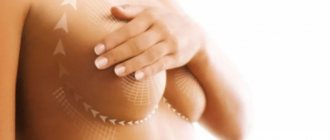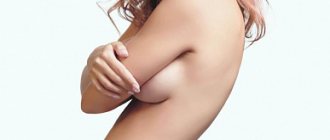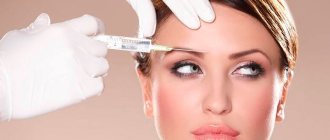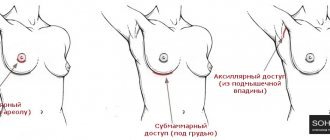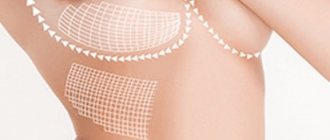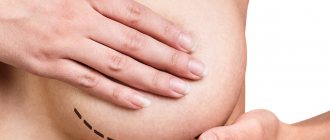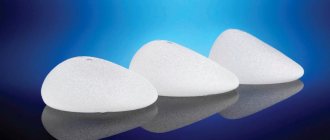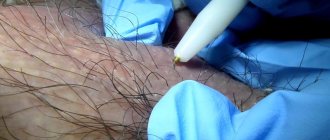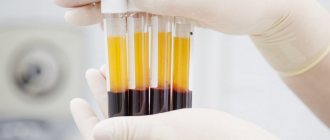Breasts are the most important asset of any woman, and of course, you want to keep them attractive for as long as possible. Unfortunately, we cannot defeat gravity - which means that all our soft tissues gradually fall down under the influence of gravity. Breasts, alas, are no exception. Changes become especially noticeable with sudden fluctuations in weight, after childbirth and breastfeeding.
If you are familiar with the problem and are looking for a solution, but don't want to undergo plastic surgery, consider a non-surgical breast lift. This procedure has been carried out at the BL Clinic for many years, with excellent results.
What types of threads do we use?
- Mesothreads (absorbable threads that are gradually completely removed from the body and are absolutely safe).
- Liquid mesothreads (hyaluronic acid and zinc chloride, provide a pronounced tightening effect and long-term results).
The doctor decides during the examination which material to choose. In some cases, materials are combined with injection or hardware techniques - this makes it possible to obtain a more pronounced and lasting effect.
Prices, photos and reviews of breast lift with threads
The cost of a breast lift with threads is several times less than surgical correction. This is due to limited indications for the procedure and lower efficiency and duration of effect. In our clinic, the price of the procedure is from 60,000 rubles (depending on the number of threads). The amount does not include local anesthesia (5000 rubles) and hospital care (3000). The total cost depends on the number of threads.
Most often, a woman who comes to the clinic for a breast lift is indicated for a surgical lift; the thread technique is very limited in indications. Therefore, there are not many reviews from women about breast lift with threads, but they are all quite positive. Women who have had a breast lift without surgery note that the breasts have taken on a higher position and anatomically impressive contours. The lack of pain and quick recovery are also mentioned in reviews of breast lift.
Often, both classic mastopexy and breast lift with threads are performed in combination with breast augmentation using implants. That is, the mammary gland is not only tightened, but also prosthetic. In many situations, a breast lift with threads is the optimal solution in this case, since some patients have almost completely no volume in the upper third of the breast and lifting alone will not give good results.
Who is this method suitable for?
Not everyone. More precisely, only for those patients whose changes are mild or moderate. Severe ptosis (usually happens if there have been sharp fluctuations in weight or the breasts are very large) cannot be eliminated with threads - in this case, the best solution would be surgical intervention. If you are concerned about sagging skin, the appearance of wrinkles in the décolleté area, or a noticeable loss of shape, mesothreads are your option.
Main indications:
- the appearance of wrinkles and folds in the chest area;
- noticeable decrease in skin tone;
- loss of shape (breasts may appear “flat” or “vague”.
Most often we perform thread lifts on women with small breasts. It is in this case that the most pronounced aesthetic result can be achieved. Those with large busts sometimes resort to thread lifting as an auxiliary method - it can be used to improve the condition of the skin on the décolleté, if necessary.
Anatomy and histology
To some, conversations about the anatomical and histological structure of the bust may seem boring, but without them you can’t get anywhere. The rib cage is formed by a bony frame of ribs, above which the pectoralis major and minor muscles are located. These muscles form the deepest layer of tissue in the anterior chest wall. They start from the ribs and end on the humerus. The main task of these muscles is to adduct the arm and rotate it inward. These muscles are not directly related to the glands.
Muscles are separated from the tissues surrounding them by dense “cases” of connective tissue called fascia. It turns out that between the muscles and mammary glands there is an additional gasket that isolates these anatomical structures from each other and makes the relationship between them even more ephemeral.
The mammary gland itself forms the superficial layer of tissue of the chest wall. Above it there are only integumentary tissues - skin and subcutaneous tissue. The gland is formed from three types of tissues - connective, which is relatively poorly developed here, fatty, which can be developed either slightly or more than well, and glandular, which, in fact, consists of the exocrine glands that perform the main function of this part of the body.
Muscle tissue is also present in the gland, but it is extremely poorly developed. Very weak! There are a small number of muscle fibers in the area of the nipple-areolar complex. In certain situations, when the sympathetic nervous system is activated, these muscles contract, which leads to changes in the structure of the nipple and areola. Such changes are well known to all women.
It is almost impossible to consciously cause contraction of these muscles, only indirectly, through certain emotional experiences and activation of the deep structures of the reticular formation (the part of the brain responsible for emotions and associated physiological reactions). During exercise, these muscles are passive. But even if they contracted, they would not be able to tighten the chest - the muscle fibers are too small for this.
How does the procedure work and what happens after it?
At the first stage, the doctor conducts an examination and carefully listens to the patient’s complaints and wishes, assesses the general state of his health and the objective condition of the problem area. Then a strategy to combat the problem is developed - the doctor, together with the patient, selects the material with which the lift will be performed, and marks the places where the threads will be installed with a special marker. Afterwards, the actual correction begins: threads are inserted under the skin and fix the breast tissue in the desired position.
Depending on the shape of the breast and the severity of ptosis, you can choose different types of access - vertical, along the halo, on one or both sides.
Discomfort during the procedure is minimal; we use local anesthesia. Almost all patients tolerate the intervention with minimal discomfort. Immediately after installing the threads, there may be an unusual feeling of tightness; you may feel something foreign on your skin - this is completely normal. Such sensations usually go away without additional intervention after a few days.
If you are planning to install threads for a breast lift in Moscow, contact our clinic by phone or through the form on the website. Our competent doctors will help you regain your self-confidence, attractiveness and sexuality. We hold reception at the address: st. Marshala Rybalko, 2k6.
POPULAR QUESTIONS
1. If I don’t like the result after the procedure or the threads stand out under the skin, can they be removed?
Yes, this is possible, but if installed correctly, the threads on the surface of the chest are invisible, so most likely you will not need to use this option.
2. Is it possible to perform such a correction on nulliparous women? I'm thin, but I've had large breasts since I was young (I'm 29 now). I am planning a pregnancy in the future, I want to feed the child, but I also want to make a correction now, because my self-esteem suffers due to the appearance of my breasts. How to decide?
Yes, nulliparous women can undergo such correction without problems. The thread lift will not affect the functional state of the gland in any way - you will be able to safely feed your child in the future if you want. Another question is that the results of the lift will most likely be lost - so if pregnancy is in your immediate plans, it may be worth postponing the correction until you complete lactation.
Advantages and disadvantages of the technique
The breast lift technique with threads involves securing the breasts in a higher position using special threads. The material of non-absorbable threads is polypropylene, which does not adversely affect the body, does not cause allergies or rejection reactions. The threads have small notches applied along the entire length, which allow them to be fixed in the tissues. Thread breast lifts can use absorbable sutures (for patients with mild ptosis), but they are less effective.
The main advantage of breast lift with APTOS threads is its minimal invasiveness. This method can rightfully be called non-surgical or seamless. The absence of scars and puncture marks makes this procedure delicate. A breast lift without surgery is performed under local anesthesia, does not involve incisions or excision of excess tissue, and the breast tissue is securely attached to the collarbone. Threads are inserted into the skin of the breast using a needle or cannula to a depth of 3-5 mm, their number is determined individually. In addition, the rehabilitation period is much easier to bear. It is much shorter and does not require a long hospital stay. Minor swelling and pain after a breast lift with threads go away within a few days. Thus, APTOS lifting involves minimal intervention.
After a thread lift, the mammary gland is raised and takes on an anatomical shape. Wearing a tight bra for the first 14 days after surgery helps consolidate the results.
The procedure for a breast lift without surgery seems quite simple to perform, but it can only be performed by a qualified and experienced specialist who can accurately determine the required number of threads and the pattern of their installation. It is worth saying that breast lift with threads is not suitable for everyone, and that is why it is so rare.
How is bio-reinforcement with threads carried out?
A thread lift does not require special preparation, however, the patient must first consult with a doctor to determine the type and number of threads, discuss all the details and draw up a lift chart.
The procedure lasts on average 30-60 minutes. Local anesthesia is usually sufficient, but general anesthesia can also be used.
The introduction of threads for tightening occurs through several pinpoint micro-punctures or notches. The doctor finds the tissue fixation point, grabs and moves the tissue where required using a thin guide needle, and secures it in the desired position. In this way, a reinforcing frame is formed, which not only supports the tissue, but also has a mechanical and biological effect that significantly improves the quality of the skin.
Traces from the manipulation heal quickly and become invisible in the future, and the rehabilitation period does not take much time.
Of course, with serious age-related changes, you should not expect the same results from the procedure as from plastic surgery, but the installation of threads is an ideal compromise for patients who are not currently ready for radical rejuvenation methods.
In addition, timely introduction of threads for tightening can save a person from plastic surgery in the future.
Choosing a clinic
It is important to understand that you should not save on this procedure, because, as you know, the miser pays twice. You need to choose not by price, but by quality.
In the modern world there are many ways to search for information, the Internet is the easiest of them. You need to prepare, read reviews about the clinics and the doctors who work there. Pay attention to negative reviews. You should definitely consult with a specialist and do not hesitate to ask all your questions.
So, after weighing all the pros and cons, you can confidently move towards change. However, do not forget about contraindications before resorting to this method of figure correction.
Anyone interested in breast thread lifting may also be interested in the following information about a facelift:
- Can sagging skin be corrected after 50 years?
- Thread lifting of the forehead, cheeks, chin and other parts of the face.
- Facelift price.
- What to expect from the procedure?
- Types of mesothreads, their use, prices and possible complications.
- What you need to know about undesirable consequences?
- Correction of eyebrows with threads.
- Threadlifting.
Pros and cons of thread lift
The obvious advantages of the technique are its simplicity, safety, speed, and short recovery period. Rejuvenation with threads gives truly impressive results.
The effect of using threads is noticeable after the first session, and there are no undesirable consequences such as scars or scars. Facial expressions and facial expressions are natural, the patient’s body movements are preserved in full.
The disadvantages of the method include the fact that not every defect can be corrected with threads. For example, it is difficult to perform the procedure if the patient is obese or has excess sagging soft tissue and skin. In such cases, more radical rejuvenation techniques are recommended.
Indications for use of threads:
- decreased tone, dry skin;
- dull complexion;
- signs of skin ptosis;
- loss of tissue volume;
- gravitational tissue ptosis;
- fine wrinkles;
- deep creases and folds;
- blurring of contours;
- facial asymmetry;
- prevention of aging.
Contraindications to thread lifting:
- tumor processes;
- diabetes;
- bleeding disorders;
- skin diseases in the acute stage;
- infectious diseases;
- chronic diseases in the acute stage;
- tendency to form keloid scars;
- individual intolerance to the drugs used;
- pregnancy and breastfeeding.
Thread lifting: age
There are no clear age limits for reinforcing the face and body with threads, since the aging process occurs differently in each individual case.
However, it is generally accepted that the procedure can be indicated for women as a prophylaxis at the age of 30+ years, for men - at the age of 35 years.
The lower limit for effective thread rejuvenation conventionally falls on the period from 50 to 55 years. But we repeat - the question of the appropriateness of the procedure must be decided individually for each specific patient.
What are mesothreads and thread lifting of the mammary glands?
Thread breast lift is a non-surgical correction method aimed at improving the shape of the mammary glands.
Thread breast lift has both disadvantages and advantages.
Minuses:
- High price.
- Contraindications for the procedure.
It is worth understanding that there is a huge difference between the method of ligature lifting of the face, the weight of the tissue is grams, and the breast, when the weight of the tissue is 200-300, and sometimes 500 grams of the volume and weight of the breast. No thread can withstand this volume, and many women experience disappointment from using these methods. Therefore, a thread lift is not performed if a woman has large breast size (third or more) and severe sagging breasts.
pros:
- Use of local anesthetic. There is no need for general anesthesia, which makes it very easy for the patient to monitor the procedure of the operation.
- Minimum period of rehabilitation and restoration of a woman’s body.
- No scars after surgery. Small skin incisions are made, which after time quickly heal and become invisible. Skin punctures are necessary to insert threads.
- The operation is performed without introducing foreign bodies (implants, fillers) into the body.
- Improving metabolic processes in a woman’s body. Some threads contain polylactic acid, which increases blood flow and improves the overall condition of the skin.
Scars after breast lift
The possibility of scarring does not stop our patients from undergoing surgery. Firstly, the surgeon will do everything to ensure that the scar is neat and inconspicuous. If the scar still causes discomfort, at LINLINE you can undergo laser scar removal using the RecoSMA method. This is a safe and painless procedure that replaces scar tissue with healthy tissue. Read more about the procedure. We give the first procedure to plastic surgery patients absolutely free.
| Consultation with a plastic surgeon | 0 ₽ | Call |
| Traditional mastopexy without reduction | from from 150000 ₽ | Call |
| Traditional mastopexy with breast volume reduction | from from 250000 ₽ | Call |
| Circular mastopexy | from from 120000 ₽ | Call |
Call us!
Rehabilitation after Aptos thread lift
Due to its minimally invasive nature, the procedure does not cause significant swelling and inflammatory processes. After the procedure, small bruises and swelling may appear on the skin at the puncture sites; they are not dangerous and require treatment.
Thread lifting can be classified as a “weekend procedure”: a couple of days after the procedure, there will be no traces left from the introduction of threads (possible bruises can be easily masked with foundation), and the result of rejuvenation will be noticeable immediately.
